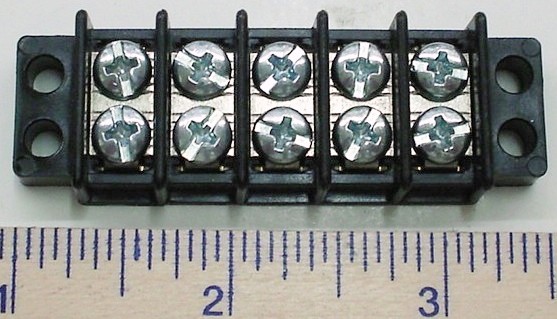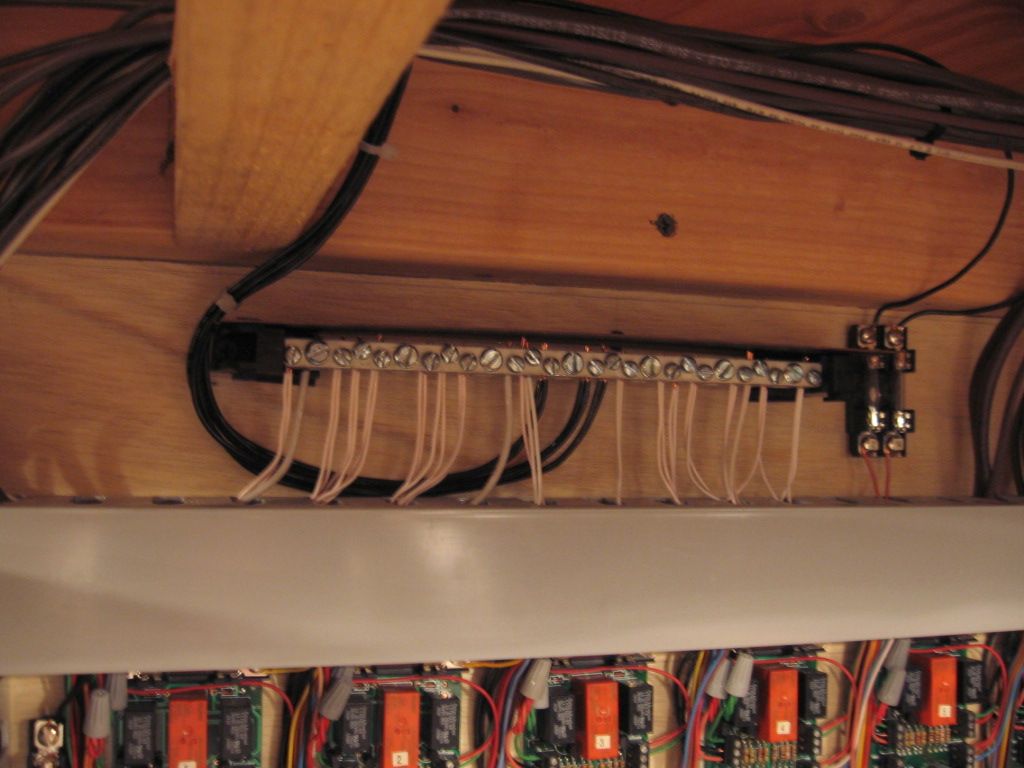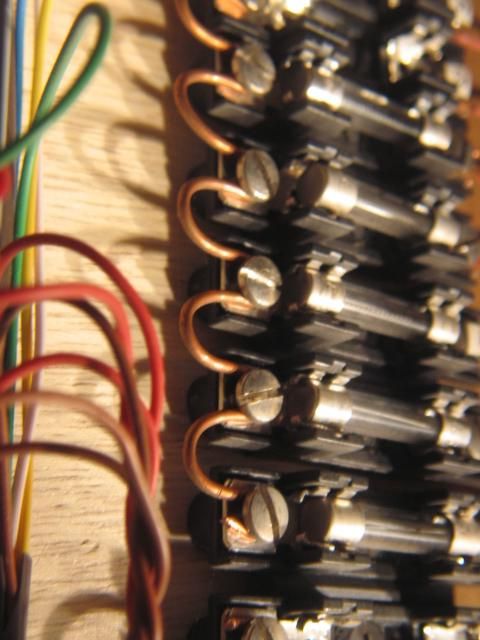Can someone please explain the actual meaning of "Terminal Strips", Barrier Strips, and "Grounding Bars"? The terms seem to be used very loosely in text.
Replies sorted oldest to newest
Terminal strips and barrier strips are kind of the same thing. The old style required crimp on terminals added to the end of the wire which connected to the screws. The euro style strips takes the wire in directly so the crimp on connectors are not needed. The terminals are connected across from each other. So if you had an 8 position strip,you would have 16 screws. Each screw would connect to the terminal across. You could jump adjacent terminals on one side for gang connections. Pre made jumpers are also available.
Grounding bars are used in home electrical panels to route all the wires inserted to common. They can also be connected to the metal box service panel itself. I use them on my layout. You can get these as bus bar extensions at home centers,there are different brands but it don't matter what kind,whatever is cheapest.
If you wade through this post,it shows some uses of both euro style and grounding bars. The layout has a shared common with all circuits,connected by grounding bars
Dale H
Where the term gets "loosely" used is when one refers to a bus type bar using these terms.
A bus type terminal strip provides multiple outputs from one input. the grounding bar in an expensive way to create a "bus terminal strip", well half of one.
Terminal strips and barrier strips are kind of the same thing. The old style required crimp on terminals added to the end of the wire which connected to the screws. The euro style strips takes the wire in directly so the crimp on connectors are not needed. The terminals are connected across from each other. So if you had an 8 position strip,you would have 16 screws. Each screw would connect to the terminal across. You could jump adjacent terminals on one side for gang connections. Pre made jumpers are also available.
Grounding bars are used in home electrical panels to route all the wires inserted to common. They can also be connected to the metal box service panel itself. I use them on my layout. You can get these as bus bar extensions at home centers,there are different brands but it don't matter what kind,whatever is cheapest.
If you wade through this post,it shows some uses of both euro style and grounding bars. The layout has a shared common with all circuits,connected by grounding bars
Dale H
Thanks Dale. Very helpful!
Ground bus bar
Barrier Strip

Where the term gets "loosely" used is when one refers to a bus type bar using these terms.
A bus type terminal strip provides multiple outputs from one input. the grounding bar in an expensive way to create a "bus terminal strip", well half of one.
Thanks Carl. Do you have a less expensive alternative to using the grounding bar? I presume that would be the bus type terminal strip. Thanks again!
The grounding bar is one of the least expensive methods when compared to buying jumpers for the terminal strips.
However, I use these 12 point terminal bus bars for transformer power distribution.
You might also add a neutral bar. Note that it is similar to the grounding bar pictured but has insulated legs/stand-offs from the metal electrical panel enclosure.
Note the black plastic ends.

Note the white plastic ends.

Ground bus bar
Barrier Strip

Tom,
Very, very helpful! Are the two holes at the ends of the Ground bus bar used to screw/attach age bus bar to the table, etc., and, do you just run the ground wire from the transformer under one of the screws, likely on the end?
Thanks again!
The grounding bar is one of the least expensive methods when compared to buying jumpers for the terminal strips.
However, I use these 12 point terminal bus bars for transformer power distribution.
Thanks Carl! The link was very helpful, and I bought several of the 12 point terminal bus bars.
You might also add a neutral bar. Note that it is similar to the grounding bar pictured but has insulated legs/stand-offs from the metal electrical panel enclosure.
Note the black plastic ends.

Note the white plastic ends.

Thanks, Mike. What do you use the neutral bar for?
In the model train world I use the neutral bars for all commons, both accessory and track common. You would use the ground bars for the same. The plastic ends would allow for insulation from the mounting surface, which in most cases would be wood, not really a problem.
In an electrical panel many times the neutral wires and ground wires are separated, i.e. the insulated black or white plastic ends are the separation, while the ground bars are attached to the metal panel enclosure with the two self-tapping screws show.
this is the old school way of using terminal barrier strips using jumper strips
this is an alternative to the jumper strips
as you can see each set of terminals opposite each other are connected so to use you connect a single power line to the input side and multiple outlets going to your light buildings accessories or what ever
you can also split the barrier strip so that half is hot and the other half is ground on the same strip
hope this helps
Attachments
Thanks for all of the help, and for the excellent photos! The wiring is going well: no barriers so far!
Cordially,
Dennis
your welcome i am glad that i could help
Not that the barrier strip isn't useful, or that suggesting the use of them is somehow wrong.....but. I was probably making my second or third one of these when I realized what a total waste of time and money they are.

I believe I'll bypass the whole mess when wiring the new layout by using those neutral bars shown earlier. It's not like we're transmitting 120 volts through them. The savings in connectors alone, not to mention barrier bars, would pay for each neutral bar.
Bruce
to each his own i like the strips due to the fact that i dont like to run even 20 volts through an aluminum strip that conducts unless it is a ground which those are for.
we are adapting Electrical components to our model railroads to use as we see fit to use however if something were to happen to the layout and a fire was caused the investigation would show what was used and could possibly be the culprit and insurance may not cover the damages
this is why i do the best that I can and limit the openness of the possibility of problems
I'm back at wiring again, and the excellent posts that Forum members made above have been a much needed and helpful refresher. Given the passage of time, I'm really glad that I reviewed this again.
The barrier strips allow for flexibility that the "neutral bars" don't allow for. I use barrier strips all the time for various uses. When used for accessory power I usually don't run the same voltage thru all of the connectors. I might run 14V to 4 of them and 8V to the rest. you just don't connect all of them to each other. In this example I connect 4 together for the 14V and tie the others together for the 8V.
Of course one does not need to do that for the ground/return wires.
- walt
walt rapp posted:The barrier strips allow for flexibility that the "neutral bars" don't allow for. I use barrier strips all the time for various uses. When used for accessory power I usually don't run the same voltage thru all of the connectors. I might run 14V to 4 of them and 8V to the rest. you just don't connect all of them to each other. In this example I connect 4 together for the 14V and tie the others together for the 8V.
Of course one does not need to do that for the ground/return wires.
- walt
Walt,
Great idea. Do use use different transformer binding posts through the 14v and 8v connectors, or do you vary the voltage to the accessories manually through the same transformer binding post depending on which accessory you are actually using at that time?
Dennis, I have a 'V' that I use for accessories. It has 4 throttles. Over time I have recorded what voltage works best for each accessory. Now knowing that I can group them into 4 divisions which is plenty. I set the throttle on the trannie and put a "do not touch" sign on it. Mostly it's just lights that I'm controlling but even there I find different voltages important. For instance, I have 40 to 50 of those Lionel street lights and many stand-alone lights that I use in structures. Being able to vary the brightness helps. You get the idea.
Since I only have a Christmas Layout, knowing how to group them each year helps make it an easier setup.
- walt
Dale, I've been looking for, but never have seen, jumper strips for the euro-style bars. Where have you seen them?
You can fabricate terminal strip jumpers. Solid #14 ga wire.


Mike CT posted:You can fabricate terminal strip jumpers. Solid #14 ga wire.
Now, THAT is clever and very neat.
Thanks, Eddie
When you can find them, Radio shack would sell barrier strips with jumpers.


These generally made these pretty easy. I have also used grounding bars/neutral bars for the same purpose. Given the low voltage I just screwed them into a scrap of 2" x 4", then mounted the block out sight.
Just to add that for a limited number of connections, the 5 position Wago connector is handy - all 5 positions are connected to each other. Wago connectors work with stranded or solid wire, supports 12ga down to 28ga, and UL listed and rated for 600v and 20amps. There is also small openings on the back (not shown) that allows use to use meter leads to probe.
I use 3 position and 5 position as I am putting my layout together.
Wago 222-415 shown below. Three position is 222-415
Attachments
MED posted:Just to add that for a limited number of connections, the 5 position Wago connector is handy - all 5 positions are connected to each other. Wago connectors work with stranded or solid wire, supports 12ga down to 28ga, and UL listed and rated for 600v and 20amps. There is also small openings on the back (not shown) that allows use to use meter leads to probe.
I use 3 position and 5 position as I am putting my layout together.
Wago 222-415 shown below. Three position is 222-415
Ok, thats really interesting. I can get a bag of 100 of the 3 position (222-413) for about 29 cents each.
Also, it appears that its internally rated at 32 amps. 12 gauge wire is only rated at 20 amps, which is why they should only list it at 20amps, but its nice to know that the internal connectors are actually rated much higher.
eddiem posted:
Thanks Eddie for showing that!!! I have about 10 of the European style and this device will really help me wire them. This forum always has helpful info and this is certainly one of those!
- walt
I use the barrier strips with dual screws. I purchase them in 28 terminal length and cut them to suit my need. My only solder connections are feeders to the track. I connect crimp lugs to the strips. The allows easy modifications, troubleshooting and repairs. The screws don't loosen either.
walt rapp posted:Dennis, I have a 'V' that I use for accessories. It has 4 throttles. Over time I have recorded what voltage works best for each accessory. Now knowing that I can group them into 4 divisions which is plenty. I set the throttle on the trannie and put a "do not touch" sign on it. Mostly it's just lights that I'm controlling but even there I find different voltages important. For instance, I have 40 to 50 of those Lionel street lights and many stand-alone lights that I use in structures. Being able to vary the brightness helps. You get the idea.
Since I only have a Christmas Layout, knowing how to group them each year helps make it an easier setup.
- walt
Thanks Walt,
Your comments will greatly assist with my current wiring project(s). By the way, what is a 'V'?
jhz563 posted:When you can find them, Radio shack would sell barrier strips with jumpers.

These generally made these pretty easy. I have also used grounding bars/neutral bars for the same purpose. Given the low voltage I just screwed them into a scrap of 2" x 4", then mounted the block out sight.
Amazon has a great selection of similar items. Here are the: "10pcs(5 Sets) 12 Positions Dual Row 600V 15A Screw Terminal Strip Blocks with Cover + 400V 15A 12 Positions Pre-Insulated Terminal Barrier Strip (Black/Red)..."Size:e)5 Set 12 Position 600V 15A Screw Terminal Strip, for $12.99 (If you search, "barrier strips with jumpers", you will find even more choices):

Attachments
MED posted:Just to add that for a limited number of connections, the 5 position Wago connector is handy - all 5 positions are connected to each other. Wago connectors work with stranded or solid wire, supports 12ga down to 28ga, and UL listed and rated for 600v and 20amps. There is also small openings on the back (not shown) that allows use to use meter leads to probe.
I use 3 position and 5 position as I am putting my layout together.
Wago 222-415 shown below. Three position is 222-415
Thanks MED, great suggestion. Here's the description for that item from Amazon, which can easily be ordered in different amounts from 10+:
"Wago 222-415 LEVER-NUTS 5 Conductor Compact Connectors 80 Pack"
10 of them are priced at $9.45. ( I haven't attempted to compare prices across suppliers, and am attempting to use this pricing as an example of availability and "ballpark" cost.)
FYI, On Amazon there is a 75-piece assortment of NON-Wago's for $19.99.
CORRECTION
MY SON POINTED OUT TO ME THAT THESE ARE NOT WAGO AND ARE NOT UL LISTED. So I would not use them in household wiring
I have one for the exact purpose discussed. 8 volts for drum loader, 14volts for Fastrack switches, 12 volts for milk car, etc.

















